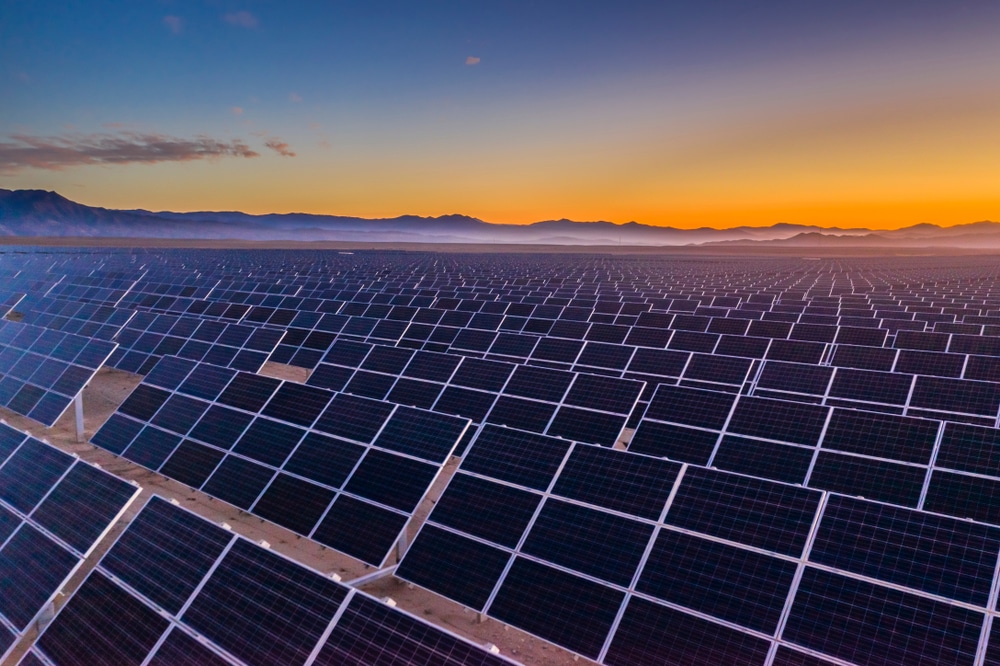The world’s biggest solar farm is being planned for Australia, and it could provide 15% of Singapore’s electricity. Atlassian co-founder Mike Cannon-Brookes has backed the $30 billion plan which will see 2,000 jobs created and $2 billion in Australian exports per year, making Australia a global solar export superpower.
‘Sun Cable’, is set to be the world’s first intercontinental power grid, connecting Australia into the ASEAN power grid. The highly ambitious project will see 125sqm of solar panels in the Northern Territory, a battery 150 times larger than the biggest in the country and a 5,000km ‘extension cable’. The solar farm will be built in the middle of the Simpson Desert.

A ‘giant extension cable’
When explaining how a solar farm in Australia could export power to Asia, Mr Cannon-Brookes described it in layman terms:
“Think about it as a giant extension cable that runs from our sunny deserts up to Asia”, he said. “There are two or three billion consumers that want cheap energy and want a lot of that energy and we have it and can provide it”.
Power lines will run from the solar farm, pass through Darwin, stretch 4,200km underwater to Indonesia and then Singapore, making it the world’s largest renewable energy transmission network.
The project also involves a battery capable of storing between 36 to 42 gigawatt hours, making it the largest in the world.
Construction is set to begin in 2024, as a result approximately 2,000 jobs are expected to be created during development with completion estimated by 2028.

Intercontinental power grids: just a pipe dream?
The concept of a green intercontinental grid with mega-sized undersea cables almost sounds like something out of a utopic science-fiction novel. Even so, Sun Cable has been given some real-world credibility, with Australia granting “major project status” to the project.
The notion of the intercontinental grid isn’t new, and it’s not the first time that the world has experimented with it.
In an opinion piece published on LinkedIn earlier this week, renewable industry experts Amit Jain and Abhinav Goyal, discussed the viability and potential challenges associated with intercontinental power grids.
Technology: Long-distance undersea HVDC (high-voltage direct current) cable transmissions already exist globally, just not at the scale proposed in the Sun Cable project. That doesn’t mean it isn’t feasible however.
In November, 2019, a 423km (400kV, 600MW) undersea power cable linking Montenegro to Italy was successfully put into operation.
“The technology for HVDC cabling has advanced phenomenally over the last few decades”, said Jain and Goyal.
Cost: The main expenses to consider are capital investments in a generator (solar PV or wind), storage, and grid infrastructure.
“If one does the math, it’s not very expensive either”, said Jain and Goyal.
As discussed in previous articles, the cost of generating solar power has fallen dramatically. Battery storage costs have also fallen in the last decade – a lithium-ion battery pack cost $156/kWh in 2019 compared to $1100/kWh in 2010.
According to the pair, the Australia-ASEAN Power Link (AAPL) could deliver the power almost half of what a consumer pays for electricity in Singapore.
“Further, the benefit it offers in terms of energy security for the participating countries and the increased use of renewables could easily lead to quicker cost recoveries.”
Geopolitics: While it may not be an issue for the Sun Cable project, the inherent intricacies of geopolitics might stand of the way of making an expanded intercontinental grid dream a reality.
“This is the Achilles heel.”
According to Jain and Goyal, the key is moving from bilateral to multilateral agreements, guided by the principles of the greater good in ensuring global energy security and economic prosperity.
Back in 2015, the State Grid Corporation of China (SGCC), made a bold attempt by conceptualising Global Energy Interconnection (GEI). It’s a vision of worldwide interconnected power grids that could bring about large-scale development, transmission, and use of renewable energy across the world.
Australia positioned to lead the way in renewable energy exports
When you think of renewable energy leadership, Australia probably isn’t one of the first countries that springs to mind. In fact, we are the world’s third largest coal exporters and have one of the least-ambitious national renewable energy targets of the OECD countries.
Despite this, Mr Cannon-Brookes believes Australia has all the natural resources needed to become the next energy super power.
“Australia should have the cheapest power on the planet”, he said. “We have so many resources opportunities in our sun and wind. We are the lucky country in terms of where we sit geographically in the world and our natural resources when it comes to renewables”.
This claim has been further cemented by the country’s foray into offshore wind farms, that have the potential to not just generate electricity for us here in Australia, but also to produce hydrogen and export that energy into other countries.
Should the Sun Cable and offshore wind farm projects go ahead as planned, they will pave the way for Australia to become a global renewable energy powerhouse that won’t have to choose between a healthy environment or a booming economy.
Want to be part of the solution? Assisting over 30,000 Australians in their transition to clean energy, Energy Matters can guide you toward a solar and/or battery storage solution that fits your lifestyle and budget. Receive up to 3, obligation-free quotes from our trusted network of accredited solar installers in Melbourne. It’s fast, free and takes the hassle out of shopping around.












































